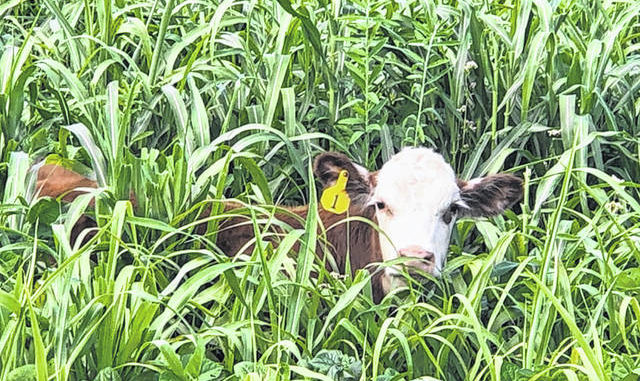Animal health, reproduction success, and adequate nutrition are critical to keeping a herd growing and increasing in number, but the key to profitability is what I’ve said many times before: weaning as many pounds of animal per forage acre as possible.
That includes hay and graze land combined because the opportunity cost of Daviess County forage land that has no mining history is grain production.
If there are areas of your perennial forage land that are in decline and in need of reseeding this fall; areas of your forage land that will not support perennial grasses and are covered with weeds during the summer, such as winter feeding areas or areas prone to winter flooding; or if there are areas of your forage land that could be in rotation with a winter cereal forage crop grown for spring harvest, warm-season summer annual grasses are a forage crop you should consider utilizing to obtain forage production that will sustain additional animals on your land.
Warm-season annuals can be planted anytime after soils warm to a consistent 65-degree temperature. Warm-season annual grasses are a truly versatile forage supplement to utilize in grazing systems.
Right now the first hay cutting is coming off.
If you have a field in a pattern of yield and quality decline, spraying a burndown now to kill the existing stand, adding adequate fertilizer, lightly tilling to smooth rough areas, and drill seeding a warm-season annual grass such as sorghum-sudan, sudan, or pearl millet will provide additional high quality forage this summer, followed this fall by additional fertilizer and new seeding of novel-endophyte fescue/orchard grass combination.
From a soil conservation and water quality standpoint, I prefer to see farms use heavy-use feeding areas of compacted rock or concrete to place hay for cattle feeding.
If you are feeding hay in areas on open pasture land, you know that those areas are without quality grass or are overgrown with broadleaf and grass weeds.
Getting forage production from these areas is possible with warm-season annual grasses. Like the renovation described above but on smaller scale, till down these sites and over seed as soon as possible.
The warm-season grass will benefit from the excess nutrients, and the soil will be covered, initiating a soil damage repair process. If a heavy-use area is not in the plan this year, return hay feeding to the site this winter but the benefit of high yielding forage has been harvested from the field instead of buttercup and cocklebur weed production.
Warm-season annual grasses fit well with farms harvesting cereal grains for forage in the spring. Ideally these cereal grain forage fields would be harvested in the spring, followed by a grain crop, allowing two crops to be harvested from the land: one crop to be fed, the second grown for cash.
If grain is not feasible, rotating the land with a summer annual forage grass followed with a winter cereal grain crop harvested for forage is an excellent rotation and a method of producing enormous forage yield on a per acre basis.
There are three primary warm-season annual grasses utilized in Kentucky. Sudangrass is a rapidly growing annual grass of the sorghum family. It is medium yielding and well-suited for grazing. Sudan grass grows quickly after harvest and can be grazed several times.
This grass has smaller stems making it well-suited for hay. Sorghum-sudan grass is also popular and is a true cross with sorghum and sudan grass.
It grows tall and, because of its height, is higher yielding than sudangrass but has a thick stem, making it more difficult to cure out to dry hay. Grazing or cutting for baleage is the preferred method of harvesting sorghum-sudangrass.
It will also regrow after harvest. Both sudangrass and sorghum-sudan are susceptible to nitrate toxicity if heavy fertilization is followed by dry conditions and prussic acid poisoning after frost.
Pearl millet is the most popular summer annual grass choice. It is high yielding, not susceptible to prussic acid, finer stemmed, better suited for dry hay, very drought tolerant, and will regrow after harvest.



